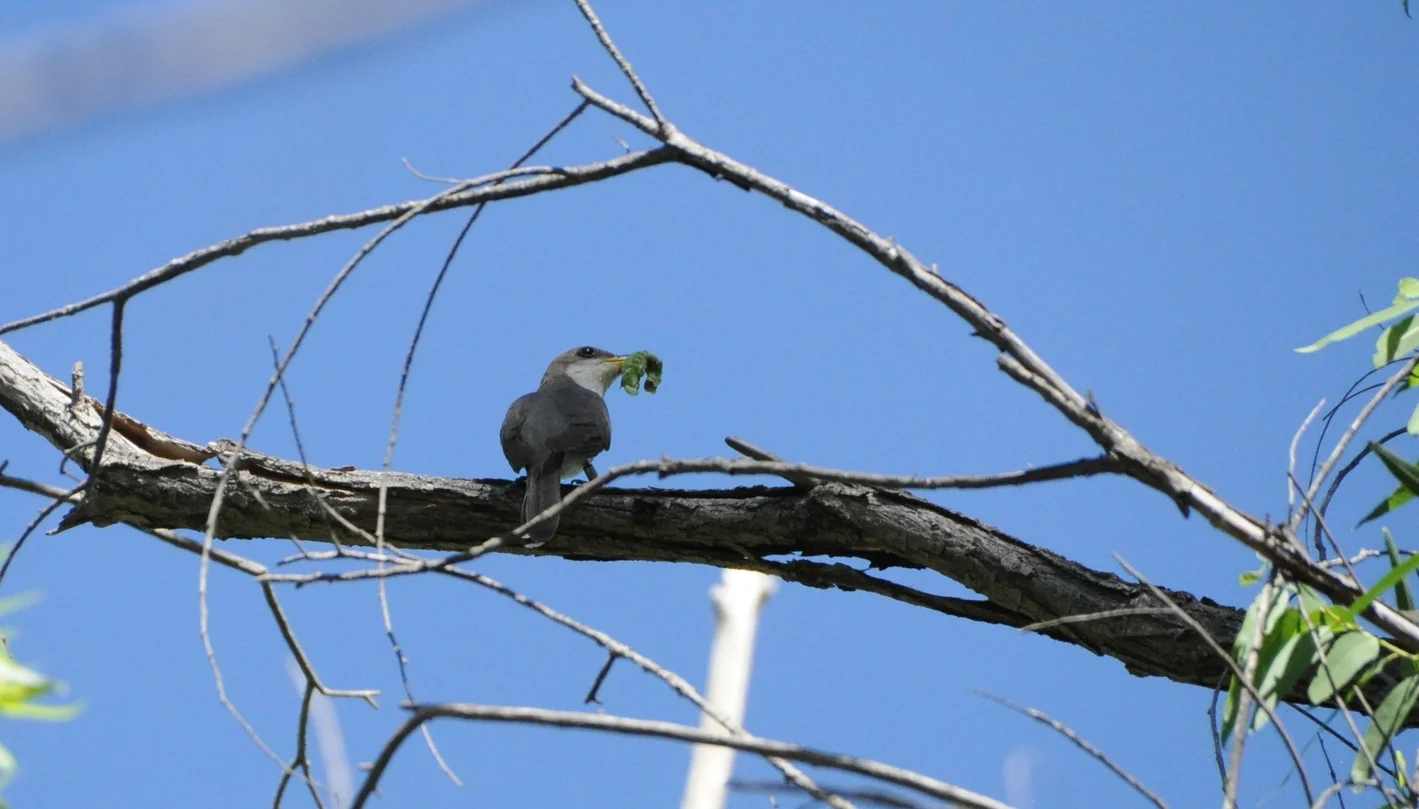Western Yellow-billed Cuckoo (Coccyzus americanus occidentalis)
Yellow-billed Cuckoo male feeding a recent fledgling
The Western Yellow-billed Cuckoo (YBCU) is secretive, medium sized passerine migratory bird that travels to the southwestern United States during the summer to breed from South America. The bird is related to a Greater Roadrunner and is visually distinct from other similar looking birds by its larger size, striking white breast, decurved yellow bill, and distinctive black/white long tail.
Listing Status
Federally Threatened (USFWS)
State Endangered (CDFW)
VOCALIZATIONS
Suitable BREEDING Habitat
The YBCU breeding grounds generally require large areas of willow-cottonwood or mesquite forest, preferring areas greater than 200 acres with a dense high canopy cover in California (Halterman et al. 2015). Habitat areas between 100-200 acres are considered suitable, and areas between 50 to 100 acres considered marginal(79 FR 48547). This species rarely nests within habitat less than 50 acres and sites less than 37 acres is considered unsuitable (Halterman et al. 2015, 79 FR 48547). Monoculture non-native tamarisk (Tamarix sp.) forests are considered unsuitable; however, the species will utilize riparian corridors where tamarisk is present (Halterman et al. 2015, 79 FR 48547). The YBCU can be characterized as being "predictably unpredictable" when it comes to classifying suitable breeding habitat as some populations and individuals will utilize habitat that others will not. It is important to keep in mind that a riparian area that may be considered too small and isolated to support breeding activities, may still be utilized during migration or early in the breeding season. Single individuals have been observed within isolated riparian patches of 1-2 acres as well as within narrow, linear riparian habitats of approximately 33-66 feet in width (Halterman et al. 2015).
The YBCU on average requires the following breeding site requirements (79 FR 48547):
- Large riparian corridor, preferably more than 200 acres, and greater than 325 feet wide
- Tree species dominated by willows, cottonwoods, and/or mesquite between 10-98 feet (average 35 feet) in height with dense canopy foliage
- Increased humidity within the habitat due to potential surface water nearby
- Adequate food sources nearby (i.e. large caterpillars, katydids, cicadas, grasshoppers, frogs)
Breeding
The YBCU is extraordinary when it comes to breeding as they are able to build, lay, incubate, and fledge a brood of young in as little as 17 days. In California, the YBCU typically arrives to its breeding grounds in late June; however, some individuals have been known arrive in mid to late May. Nesting may occur between late May to September; however the vast majority of nesting occurs between late June through late July. This species have been observed in California as late as mid-September.
Primitive stick nests, in kind to a large Mourning Dove nest, is built very quickly by both parents--often they are still adding material to the nest during incubation. Incubation is started upon the laying of the first egg, with each additional laid every second day, and clutch sizes varying between 2-4 eggs. Eggs are incubated 9-11 days and young fledge between 5-8 days after hatching. The male incubates at night and both parents attend to the nest during the day. Oftentimes, towards the latter end of the nesting process, females start advertising within a nearby territory in order to nest again. Post fledgling, it appears that males are the primary attendee to the juveniles. In years when there are strong amounts of prey food available, double and triple broods may be possible (Halterman et al. 2015).
Survey Requirements
It is necessary to conduct a pre-survey habitat assessment in order to properly assess where the suitable habitat exists as riparian areas are highly dynamic and can change dramatically within the short span of a year. It is also imperative to properly map out the survey route prior to conducting the survey.
A total of four surveys is required during three survey periods in order to determine presence/absence. The first survey is conducted between June 15-June 30, the second and third surveys are typically conducted between July 1- July 31, and the final fourth survey is conducted between August 1-August 15. Each survey must be conducted between 12-15 days from the previous survey round. It is recommended that YBCU surveys are not combined with any other focused nesting bird surveys.
Conservation Status
The YBCU was designated as federally listed under the Endangered Species Act on November 3, 2014. Population decline is due to riparian habitat loss due to human altered hydrology, agriculture, livestock overgrazing, non-native species encroachment, fragmentation, and potentially pesticide use that is adversely affecting their prey base (79 FR 48547). The non-profit Southern Sierra Research Station is at the forefront of YBCU research and conservation, based in Weldon, CA. They conduct YBCU research within the Kern River Valley and along the Lower Colorado River from Lake Mead down to the US-Mexican border.
Documents/Links
California Partners in Flight- Western Yellow-billed Cuckoo Species Profile
Cornell Lab of Ornithology YBCU Species Profile
Yellow-billed Cuckoo Survey Form (Southern Sierra Research Station)
Yellow-billed Cuckoo Vocalizations (Southern Sierra Research Station)
Southern Sierra Research Station YBCU Workshop Information
References
79 FR 48547. Endangered and Threatened Wildlife and Plants; Designation of Critical Habitat for the Western Distinct Population Segment of the Yellow-Billed Cuckoo; Proposed Rule. Federal Register / Vol. 79, No. 158 / Friday, August 15, 2014 / Proposed Rules.
Halterman, M., M.J. Johnson, J.A. Holmes and S.A. Laymon. 2015. A Natural History Summary and Survey Protocol for the Western Distinct Population Segment of the Yellow-billed Cuckoo: U.S. Fish and Wildlife Techniques and Methods, 45 p.






